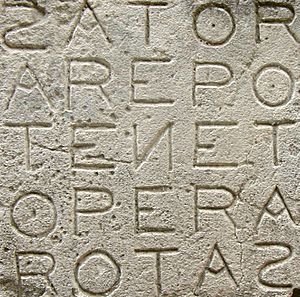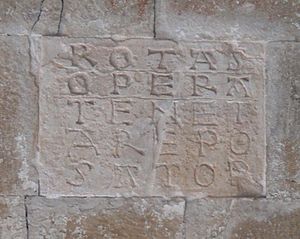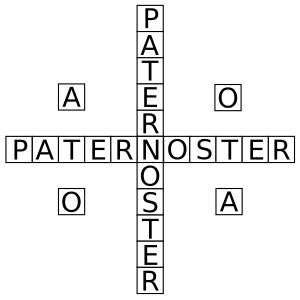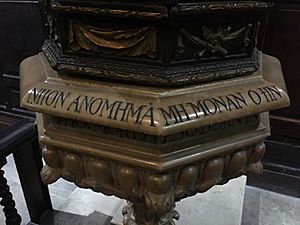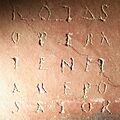Sator Square facts for kids
The Sator Square is a special group of five Latin words arranged in a square. It's a type of word square that reads the same forwards, backwards, up, and down! This makes it a palindrome. People have found examples of this square in very old places, like the ruins of Pompeii. This shows it was used a long time ago, possibly even before Christianity became widespread.
Contents
What is the Sator Square?
How it Looks
The Sator Square is a 5x5 grid of letters. This means it has five rows and five columns. Each of the five words has five letters. In total, there are 25 letters, but they only use 8 different Latin letters.
Here's how the words are usually arranged:
| S A T O R |
| A R E P O |
| T E N E T |
| O P E R A |
| R O T A S |
You can read the words from top to bottom, bottom to top, left to right, or right to left. If you turn the square upside down, it still reads the same way!
What the Words Mean
The five words in the Sator Square are:
- SATOR: This means "sower" or "planter." It can also mean "founder" or "originator," sometimes referring to God.
- AREPO: This word is a mystery! It doesn't appear anywhere else in Latin writings. Most experts think it's a special name, perhaps invented for this square. Some believe it might be an old Egyptian name.
- TENET: This means "he/she/it holds," "keeps," or "possesses."
- OPERA: This word can mean "work," "effort," "care," or "deeds."
- ROTAS: This means "wheels." It can also mean "you turn" or "cause to rotate."
One common way to translate the square is: "The farmer Arepo holds the wheels with effort." This suggests a farmer working with a plough. Another idea is "The farmer Arepo has wheels as his works," meaning his job involves wheels.
Christian Connections
Many people believe the Sator Square has a special meaning for Christians. If you take the letters from the square and rearrange them, you can form a Greek cross. This cross reads "Pater Noster" both down and across. "Pater Noster" is Latin for "Our Father," which are the first words of the Lord's Prayer.
The letters left over are two 'A's and two 'O's. These are often seen as representing "Alpha and Omega." In Christianity, Alpha and Omega are the first and last letters of the Greek alphabet, symbolizing God's presence from beginning to end.
Because of this, some think the Sator Square was a secret symbol for early Christians. It allowed them to recognize each other without being obvious. For example, a Sator Square found in Manchester, England, from the 2nd century AD, is thought to be one of the earliest signs of Christianity in Britain.
Some old Christian stories also connect the words of the Sator Square to the five nails used in Christ's crucifixion.
Magical Uses
Because the Sator Square is a palindrome (it reads the same forwards and backwards in many ways), some people believed it had magical powers. They thought the repeating letters could confuse evil spirits or protect against bad luck.
The square has been used in folk magic for different purposes:
- To put out fires.
- To remove curses or fevers.
- To protect farm animals from witchcraft.
- To prevent tiredness during travel.
Sometimes, people believed the square had to be written on a specific material or with a certain type of ink to work. It was often placed on houses and barns for protection.
Where to Find the Sator Square
Historical Discoveries
The oldest known Sator Square was found in the ancient city of Pompeii, which was buried by a volcano in 79 AD. This shows how old the square is!
Other examples have been discovered in many places, including:
- Under the church of S. Maria Maggiore in Rome, Italy.
- In Cirencester, England.
- In Dura-Europos, Syria.
- At the Abbey of St Peter ad Oratorium in Italy, carved into marble.
- On the outside wall of the Siena Cathedral in Italy.
- In the old town of Oppède, France, on a wooden door.
- At the museum in Conimbriga, Portugal.
- On a rune stone in Sweden, dating back to the 14th century.
Images for kids
See also
 In Spanish: Cuadrado sator para niños
In Spanish: Cuadrado sator para niños


